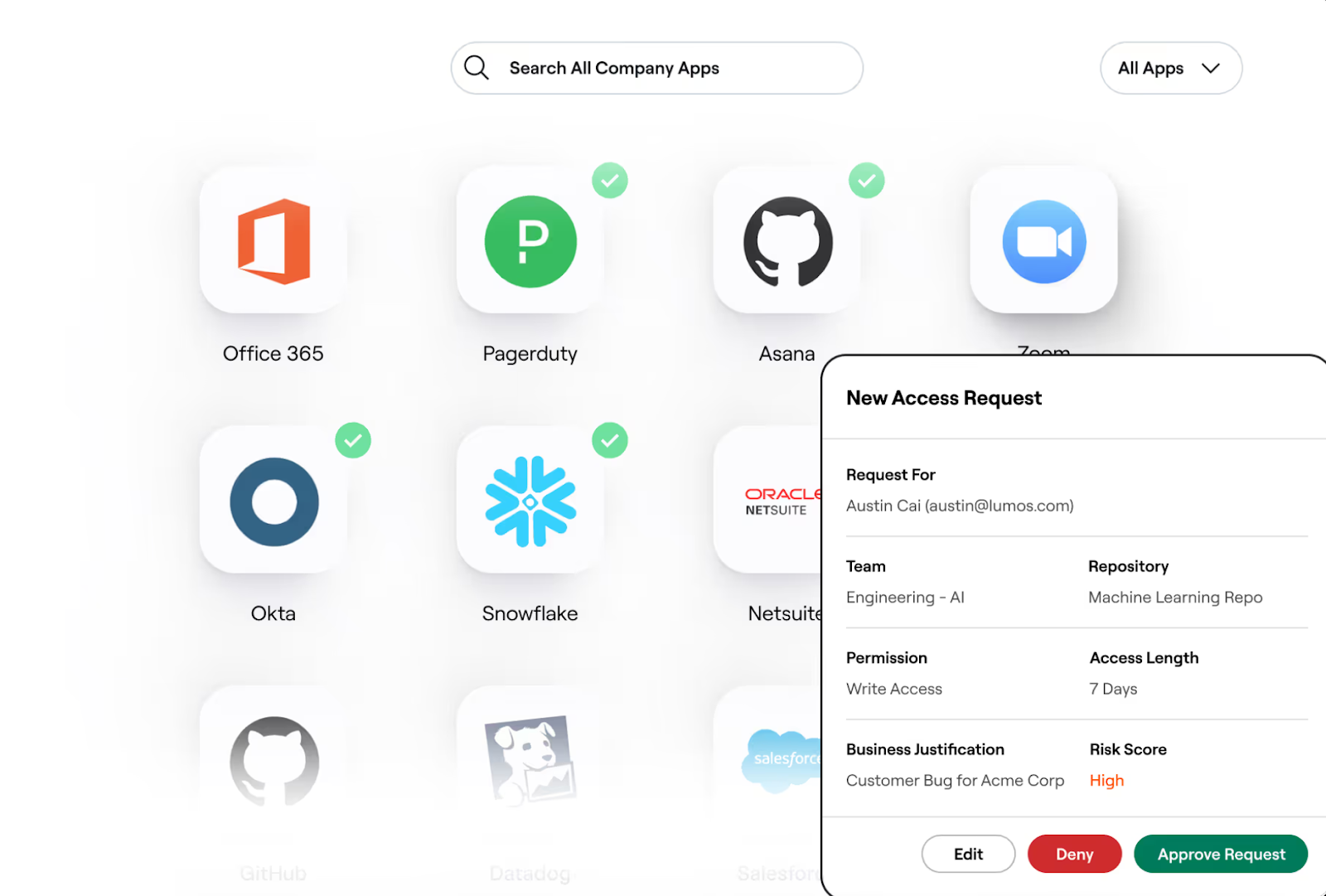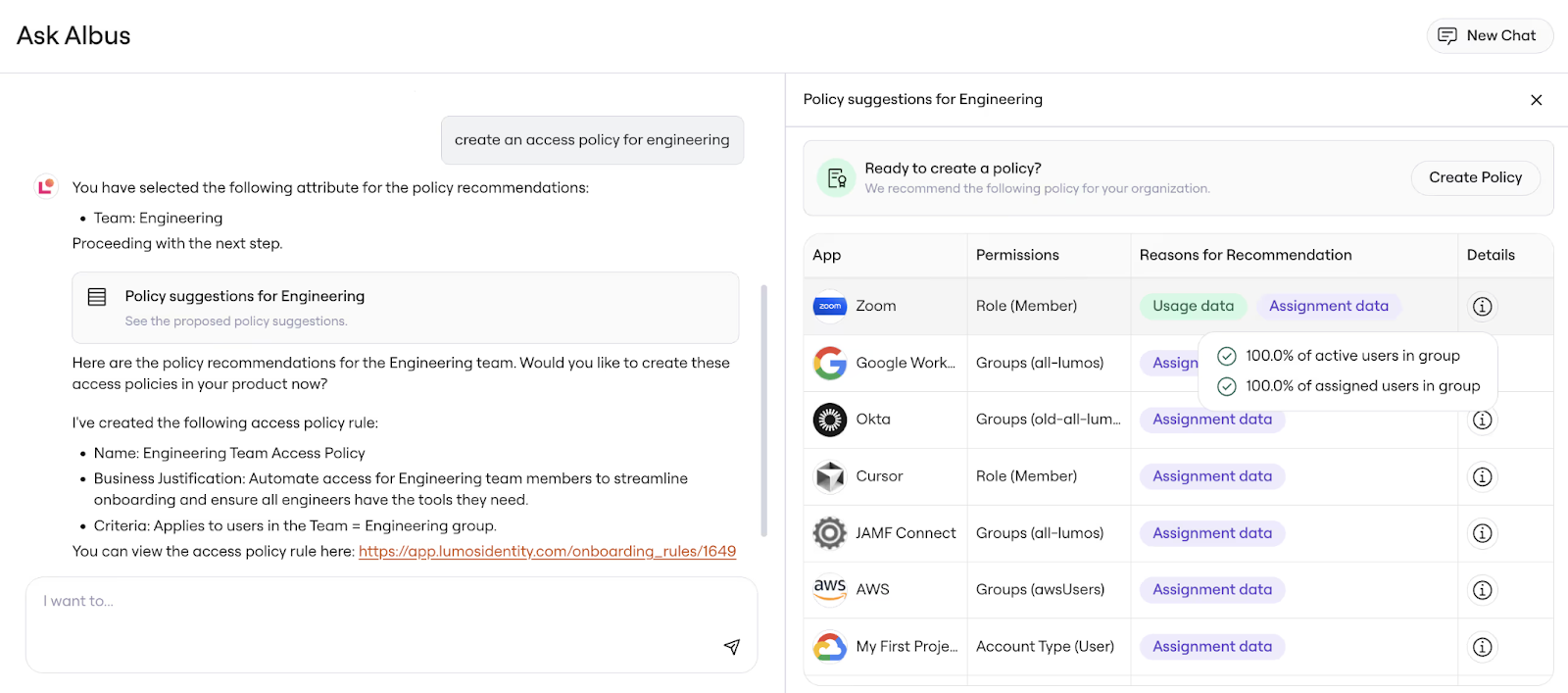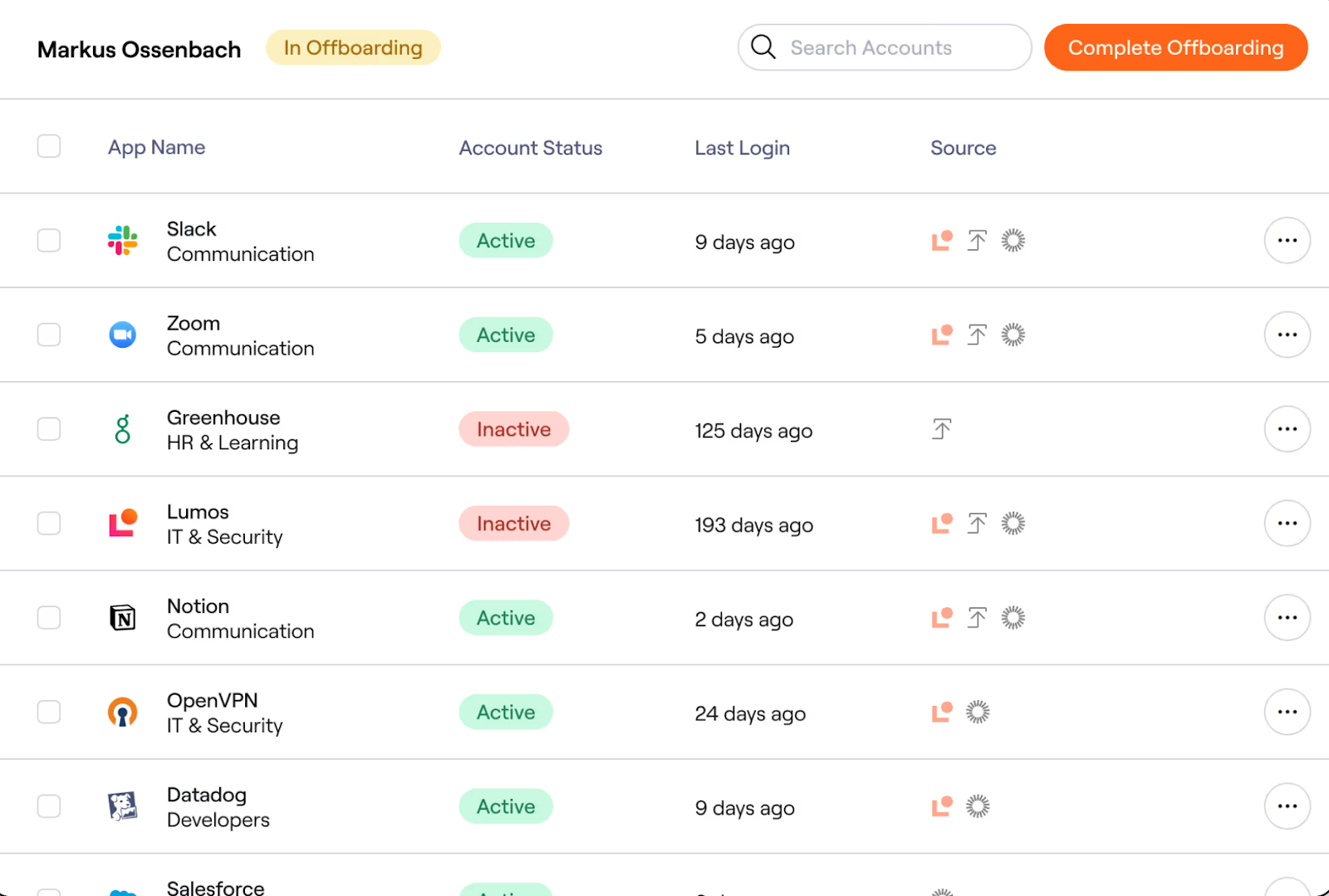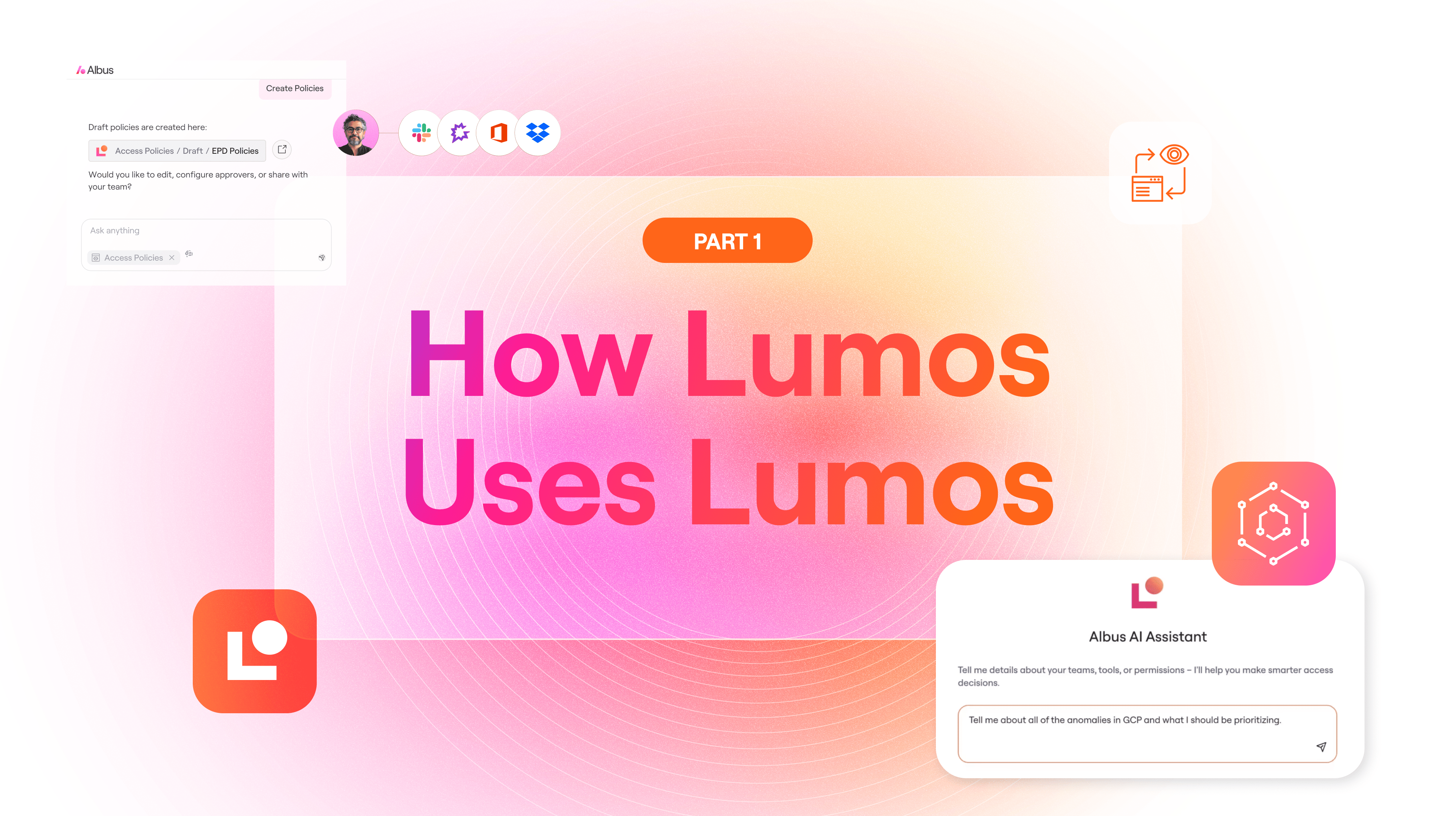
How Lumos Speeds Up Onboarding and Offboarding
Discover how Lumos accelerates onboarding and offboarding with automated provisioning, self-service access, and AI-driven role recommendations. Learn how faster identity lifecycle management improves IT productivity, reduces risk, and enhances the new hire experience.

In this article
Accelerating onboarding isn’t just a nice-to-have; it’s a strategic advantage. Research shows that organizations with structured onboarding programs increase new hire retention by up to 82% and improve productivity by over 50% . Yet, despite this clear benefit, many teams still rely on fragmented tools, ticketing systems, and manual handoffs to manage access lifecycle – creating inefficiencies, delays, and avoidable security risks.
That’s where Lumos steps in. Built and run on our own Autonomous Identity Platform, Lumos enables organizations to deliver seamless, secure access experiences for new hires and departing employees alike. By automating provisioning tasks, orchestrating access workflows, and enforcing least‑privilege policies from day one, Lumos helps IT and security teams transform onboarding and offboarding from operational bottlenecks into competitive strengths.
In the sections ahead, we’ll explore the business value of faster identity lifecycle management, how Lumos differentiates through automation and AI‑driven governance, and real-world use cases that demonstrate the impact Lumos delivers: from IT productivity gains to improved compliance and user experience.
Why Fast, Secure Onboarding and Offboarding Matters
Onboarding and offboarding are more than just operational checklists for successful organizations, they’re critical control points for productivity, security, and compliance. Whether you're welcoming a new hire or offboarding a departing employee, the speed and accuracy of these processes directly impact how well your organization functions and how safely it operates.
The Business Impact of Delayed Onboarding
When onboarding is slow, disjointed, or manual, it drags down productivity and frustrates everyone involved. New hires often wait days, or even weeks, to get access to the tools and apps they need to do their job. This delay impacts time-to-productivity, creates unnecessary downtime, and leads to frustration.
Even when systems are available, access friction – like unclear approval chains or inconsistent access requests – causes confusion and frustration. Employees spend time chasing app access instead of ramping up. IT teams are left fielding support tickets that could have been avoided with better automation.
Meanwhile, every onboarding delay adds to the IT backlog. When access provisioning is tied to manual workflows or ticket queues, admins get bogged down with repetitive requests and follow-ups, which takes time away from higher-value initiatives like automation, security hardening, or infrastructure improvements.
The Security Risks of Ineffective Offboarding
Offboarding can be even more consequential. When employees leave, lingering access to sensitive systems can lead to serious security and compliance risks. Orphaned accounts, those that remain active after an employee departs, are prime targets for attackers and internal misuse. They also represent a clear failure to enforce least-privilege principles.
Overprovisioned accounts that go unrevoked not only expand your attack surface but also drive up software costs. Licenses remain tied to inactive users, wasting budget and complicating vendor audits. Meanwhile, if offboarding isn’t well-documented or coordinated across departments, compliance teams are left scrambling to prove controls during audits.
Finally, there's the insider threat risk: if access isn’t revoked in a timely and complete way, former employees may retain the ability to access systems – intentionally or accidentally – after they’ve left the organization.
Fast, automated onboarding and offboarding isn’t just efficient – it’s essential to secure, compliant, and scalable IT operations. Lumos helps organizations tackle these challenges head-on, turning lifecycle management into a strategic advantage.
What Slows Down Onboarding and Offboarding?
Despite its importance, onboarding and offboarding remain painfully slow and inconsistent in many organizations. What should be a seamless and secure identity lifecycle experience often turns into a tangled web of emails, tickets, approvals, and guesswork. The root of the problem? Overreliance on manual workflows, siloed systems, brittle scripts and static access control management that weren’t built for scale.
Manual Workflows and Ticketing Bottlenecks
In many environments, IT is the default gatekeeper for provisioning and deprovisioning access. Every new hire request – whether it’s for a SaaS tool, admin permission, or a project-specific app – flows through IT, usually via JIRA or another ITSM platform. That means IT is not only responsible for executing access changes but also for interpreting what access is needed, chasing down approvals, and following up on task completion.
These ticket-based processes create friction at every step. Tickets get stuck waiting for context, routed to the wrong team, or simply delayed because IT has no clear insight into who owns what. There's no real-time visibility into status, no built-in accountability, no clear ownership, and no easy way to track progress across the lifecycle. The result? Delays for employees, frustration for IT, and increased risk of error.
Siloed Systems and Unclear App Ownership
Another major challenge is the lack of centralized visibility into user access. When HRIS, IdPs, and SaaS apps all operate in silos, there’s no single source of truth for understanding who has access to what, or why. As a result, access provisioning becomes a guessing game, and offboarding becomes an audit nightmare.
App ownership is often undocumented or poorly enforced. This leads to missed approvals, delayed access, and a lack of accountability when something slips through the cracks. Without a clear, integrated system for managing access lifecycle, onboarding takes longer, offboarding leaves gaps, and IT bears the burden of coordination across every department.
These inefficiencies aren’t just operational annoyances; they’re a serious drag on IT productivity and security posture. That’s why more organizations are turning to platforms like Lumos to unify their access workflows, reduce manual effort, and ensure lifecycle events trigger the right actions, every time.
How Lumos Speeds Up the Onboarding Process
At Lumos, we believe that onboarding should be seamless: for both IT and employees. A slow or fragmented onboarding process delays productivity, creates unnecessary ticket volume, and increases the risk of overprovisioned access. That’s why we’ve designed our platform to automate and accelerate onboarding from every angle – eliminating friction, enforcing least privilege, and getting new hires up and running on day one.
Automated Access Provisioning Based on HR Events
With Lumos Lifecycle Management, onboarding begins the moment a new hire is added to your HRIS. By integrating directly with systems like Workday or BambooHR and syncing with your Identity Provider (e.g., Okta or Azure AD), Lumos automatically triggers provisioning workflows as soon as an employee is marked as a “joiner.”
Birthright access – like email, Slack, or internal portals – is provisioned automatically based on role, department, or location. That means no manual approvals, no JIRA tickets, and no delays. Employees start their first day with the essential tools they need, while IT maintains full visibility and control behind the scenes.
Self-Service App Requests via AppStore + Slack
Not every app needs to be provisioned automatically. For apps outside of the birthright set, Lumos enables new hires to request access directly through the Lumos AppStore on a browser, via direct Slack or Teams, or through CLI or even ITSM. This gives employees immediate visibility into available apps and their designated approvers with request status.

Instead of routing every request through IT, Lumos sends approvals directly to the app owners or grants access instantly with pre-approval policies. This speeds up the process and eliminates IT tickets, freeing up teams. App owners can manage their own tools while maintaining oversight. Notifications in Slack or Teams, email and ITSM ticket updates keep everyone in the loop, ensuring no requests fall through the cracks.
Role-Based Access with AI Recommendations
To further streamline onboarding, Lumos leverages Albus – our AI identity agent – to recommend role-based access bundles based on team, usage patterns, and historical data. This helps IT and app owners identify what access new hires typically need without overprovisioning or relying on guesswork.

These intelligent recommendations ensure new employees have everything they need, and nothing they don’t, accelerating time to productivity while enforcing least privilege from day one. With Lumos, onboarding becomes not just faster, but smarter.
How Lumos Streamlines Offboarding
Offboarding may be the final step in the employee lifecycle, but it’s one of the most critical for security, compliance, and operational hygiene. Yet for many IT teams, it’s also one of the most manual. Tracking down app access, chasing approvals, and closing out licenses can take days – and mistakes can have real consequences. Lumos solves this with automated, visibility-driven workflows that ensure every offboarding is secure, complete, and audit-ready.
Real-Time Offboarding Checklists
Lumos Lifecycle Management automatically generates offboarding checklists based on real-time user access data: no more static lists, guesswork, or spreadsheets. As soon as an employee is marked as a “leaver” in the HRIS or Identity Provider, Lumos pulls a list of all apps the user accessed across the organization.
Each app owner is automatically notified with a task to revoke access. Lumos handles reminders and follow-ups via the Task Center, and if any tasks are stalled, IT can nudge app owners directly in the platform. This keeps the process moving while distributing the workload, ensuring nothing falls through the cracks.

Deprovisioning Across All Connected Systems
In addition to coordinating app owner actions, Lumos integrates directly with your Identity Provider (e.g., Okta, Azure AD) and connected SaaS apps to automate account deprovisioning. That means users are not only disabled at the directory level; they’re removed from every app they’ve been provisioned into, across SaaS, cloud and on-prem environments.
Whether it’s Salesforce, Zoom, GitHub, or Google Workspace, Lumos ensures full access is revoked without IT needing to manually intervene. This reduces the risk of orphaned accounts, eliminates overprovisioned licenses, and helps your organization maintain strong least-privilege enforcement.
Audit Trails and Compliance Evidence
Every offboarding action, automated or manual, is logged and stored in Lumos. That includes task completion timestamps, app owner responses, and revocation confirmations. This centralized audit trail gives Risk and Compliance teams everything they need to demonstrate proper access controls during audits and assessments.
Whether you’re preparing for SOC 2, SOX, or internal GRC reviews, Lumos Access Reviews provides complete visibility into who had access, when it was removed, and how the process was enforced – no digging through tickets or disconnected systems required. Offboarding becomes faster, more secure, and fully compliant; by default.
Use Cases: Lumos in Action
The real impact of Lumos comes to life when it’s applied to everyday challenges across IT, security, and compliance teams. From reducing IT workloads to improving audit outcomes, Lumos turns onboarding and offboarding into high-impact, low-effort workflows that scale with your organization. Below are a few ways we’ve seen Lumos deliver immediate and measurable results.
- IT Productivity and Ticket Reduction
- Complete Lifecycle Orchestration Across All Systems
- Streamlined Audit Trails and Compliance Evidence
IT Productivity and Ticket Reduction
After deploying the Lumos platform, Checkr achieved a 20% reduction in IT tickets, enabling the team to shift focus from reactive firefighting to strategic priorities.
Read the full case study here.
Complete Lifecycle Orchestration across All Systems
With Lumos, Marqeta was able to automate the onboarding and offboarding processes, managing access to more than 150 apps - in under 2 months. This eliminated the need for overhead work that had previously relied on CSV files, tickets, and endless manual steps.
Read the full case study here.
Streamlined Audit Trails and Compliance Evidence
Sun Country used Lumos to automate access reviews which freed up valuable IT resources to focus on other strategic initiatives. Lumos helped Sun Country save 50 hours per quarter by allowing reviewers to focus primarily on access that has changed since the previous review cycle - eliminating redundant and repetitive work.
Read the full case study here.
Turn Onboarding and Offboarding a Strategic Advantage with Lumos
Onboarding and offboarding are critical moments in the identity lifecycle; and how effectively they’re managed can make or break both security posture and user experience. When done right, onboarding accelerates productivity and boosts retention; when done poorly, it introduces friction, risk, and inefficiency. Likewise, timely and complete offboarding is essential to protecting your organization from privilege creep, compliance gaps, and insider threats.
For IT and security leaders, the challenge is striking the right balance between speed, security, and control – without overburdening their teams or relying on patchwork workflows.
Lumos makes that balance possible. As the Autonomous Identity Platform, Lumos automates onboarding and offboarding from end to end. By integrating with your HRIS and IdP, orchestrating app owner workflows, and enforcing least privilege from day one, Lumos eliminates manual processes and ensures that every user gets the right access: no more, no less.
With Lumos, organizations gain real-time visibility into access, leverage AI-driven insights to minimize overprovisioning, and maintain audit-ready records across all systems. Whether you're onboarding at scale or offboarding securely, Lumos helps your team move faster, reduce risk, and operate with confidence.
Ready to streamline your onboarding and offboarding processes? Book a demo with Lumos and see how automation can unlock a faster, smarter future.
















